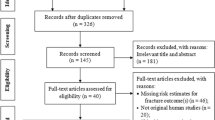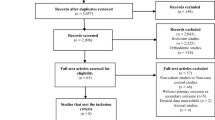Abstract
In the last 15 years, several pharmacological agents for the prevention of fractures have been developed and commercialized. Most of them showed to be effective in reducing fracture risk. The enhanced availability of drugs to prevent fractures has generated a fierce competition among pharmaceutical companies to conquer a share of the potential market, often with claims of superiority of a drug over another without direct comparisons. The definitive way to compare different treatments would require randomized head to head trials. These trials are expensive, need large samples and are unlikely to be ever performed. Therefore, it has become a common practice to compare pharmacological agents through observational studies on administrative databases or by the indirect comparison of the results of individual randomised-controlled trials (RCT) and their meta-analyses. These studies may produce evidence of clinical value, complementary to that given by RCT. However, without a proper and complete analysis, they may result in a biased picture of effectiveness and be completely misleading. In this article, we critically disclose how such competition may produce biased and misleading picture of evidence, by reviewing the significance of the number needed to treat, absolute risk reduction and relative risk reduction in relation to vertebral fractures prevention with available drugs.
Similar content being viewed by others
References
Holroyd C, Cooper C, Dennison E. Epidemiology of osteoporosis. Best Pract Res Clin Endocrinol Metab 2008, 22: 671–85.
Body JJ, Bergmann P, Boonen S, et al. Evidence-based guidelines for the pharmacological treatment of postmenopausal osteoporosis: a consensus document by the Belgian Bone Club. Osteoporos Int 2010, 21: 1657–80.
Concato J, Peduzzi P, Huang GD, O’Leary TJ, Kupersmith J. Comparative effectiveness research: what kind of studies do we need? J Investig Med 2010, 58: 764–9.
Ringe JD, Doherty JG. Absolute risk reduction in osteoporosis: assessing treatment efficacy by number needed to treat. Rheumatol Int 2010, 30: 863–9.
Reginster JY, Deroisy R, Neuprez A, Hiligsmann M, Zegels B, Bruyere O. Strontium ranelate: new data on fracture prevention and mechanisms of action. Curr Osteoporos Rep 2009, 7: 96–102.
Neuprez A, Hiligsmann M, Scholtissen S, Bruyere O, Reginster JY. Strontium ranelate: the first agent of a new therapeutic class in osteoporosis. Adv Ther 2008, 25: 1235–56.
Ortolani S, Vai S. Strontium ranelate: an increased bone quality leading to vertebral antifracture efficacy at all stages. Bone 2006, 38(Suppl 1): 19–22.
NNT, nell’osteoporosi meglio il ranelato di stronzio? Il Giornale della SIOMMMS. http://www.ilgiornaledellasiommms.it/index.html?cat=5&id=98. Published 13/03/2010, last accessed 05/08/2010.
Cook RJ, Sackett DL. The number needed to treat: a clinically useful measure of treatment effect. BMJ 1995, 310: 452–4.
Higgins JPT, Green S (eds). Cochrane handbook for systematic reviews of interventions. Version 5.0.1 [updated September 2008]. The Cochrane Collaboration. Available from www.cochrane-hand-book.org
McAlister FA. The “number needed to treat” turns 20 — and continues to be used and misused. CMAJ 2008, 179: 549–53.
Meunier PJ, Roux C, Seeman E, et al. The effects of strontium ranelate on the risk of vertebral fracture in women with postmenopausal osteoporosis. N Engl J Med 2004, 350: 459–68.
Black DM, Cummings SR, Karpf DB, et al. Randomised trial of effect of alendronate on risk of fracture in women with existing vertebral fractures. Fracture Intervention Trial Research Group. Lancet 1996, 348: 1535–41.
Ettinger B, Black DM, Mitlak BH, et al. Reduction of vertebral fracture risk in postmenopausal women with osteoporosis treated with raloxifene: results from a 3-year randomized clinical trial. Multiple Outcomes of Raloxifene Evaluation (MORE) Investigators. JAMA 1999, 282: 637–45.
Chesnut III CH, Skag A, Christiansen C, et al; Oral Ibandronate Osteoporosis Vertebral Fracture Trial in North America and Europe (BONE). Effects of oral ibandronate administered daily or intermittently on fracture risk in postmenopausal osteoporosis. J Bone Miner Res 2004, 19: 1241–9.
Black DM, Delmas PD, Eastell R, et al. Once-yearly zoledronic acid for treatment of postmenopausal osteoporosis. N Engl J Med 2007, 356: 1809–22.
Harris ST, Watts NB, Genant HK, et al. Effects of risedronate treatment on vertebral and nonvertebral fractures in women with postmenopausal osteoporosis: a randomized controlled trial. Vertebral Efficacy with Risedronate Therapy (VERT) Study Group. JAMA 1999, 282: 1344–52.
Neer RM, Arnaud CD, Zanchetta JR, et al. Effect of parathyroid hormone (1–34) on fractures and bone mineral density in postmenopausal women with osteoporosis. N Engl J Med 2001, 344: 1434–41.
O’Donnell S, Cranney A, Wells GA, Adachi JD, Reginster JY. Strontium ranelate for preventing and treating postmenopausal osteoporosis. Cochrane Database Syst Rev 2006, 3: CD005326.
Author information
Authors and Affiliations
Corresponding author
Rights and permissions
About this article
Cite this article
Pedrazzoni, M., Giusti, A. & Pioli, G. Uses and misuses of statistics: The case of strontium ranelate and the number needed to treat. J Endocrinol Invest 34, 572–575 (2011). https://doi.org/10.1007/BF03345397
Accepted:
Published:
Issue Date:
DOI: https://doi.org/10.1007/BF03345397




